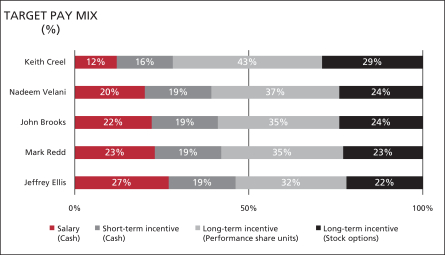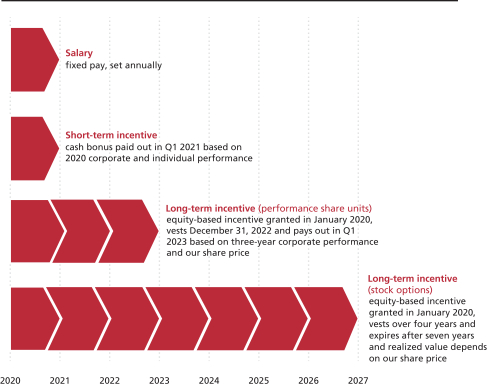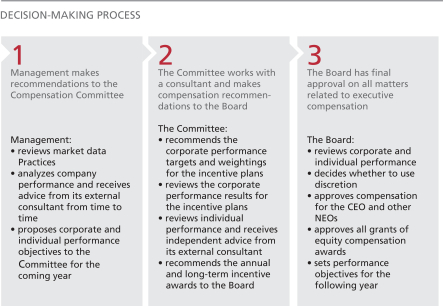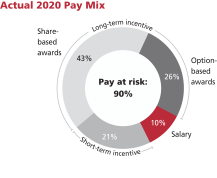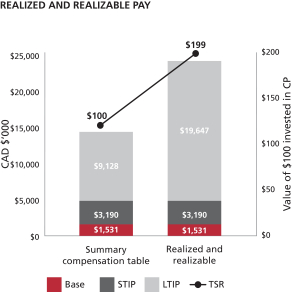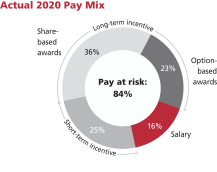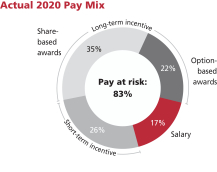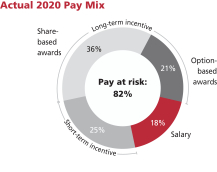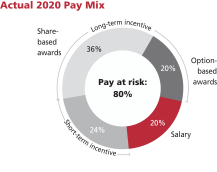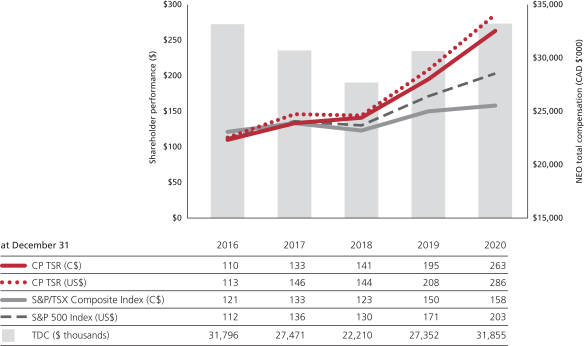PART III
ITEM 10. DIRECTORS, EXECUTIVE OFFICERS AND CORPORATE GOVERNANCE
Directors
| Director profiles All 11 nominated directors are qualified and experienced, and have agreed to serve on our Board. Directors are elected for a term of one year until the close of our next annual meeting of shareholders, unless a director resigns or is otherwise removed earlier. Share Ownership All directors are CP shareholders and must meet our director share ownership requirements within five years of joining the Board. Share ownership listed here is as at February 26, 2021 and includes shares directors beneficially own or control, or hold directly or indirectly. Share ownership includes holdings under the Directors’ Deferred Share Unit (DDSU) plan. See page 52 for full details on share ownership by our directors. 100% Attendance during 2020 The 2021 nominee directors attended all of their Board and Committee meetings in 2020. Professional Associations All of the 2021 nominee directors are members of the Institute of Corporate Directors (ICD). |
| Isabelle Courville Chair | ||
 |
Independent Age: Director since: May 1, 2013 Residence: Québec, Canada 2020 voting results: 99.63% for | |
| DIRECTOR SKILLS AND QUALIFICATIONS Brings expertise in the following areas: senior executive leadership, accounting & financial literacy, accounting & financial expertise, environment, health & safety, executive compensation/human resources, transportation industry knowledge, governance, government/ regulatory affairs and legal, risk management, sales & marketing and strategic oversight. |
| OVERALL 2020 ATTENDANCE |
100% |
|||||
Meeting Attendance |
||||||
| Board | 9 of 9 | 100% | ||||
| Audit and Finance | 5 of 5 | 100% | ||||
| Governance | 5 of 5 | 100% | ||||
| Compensation | 6 of 6 | 100% | ||||
| Risk and Sustainability | 4 of 4 | 100% | ||||
BUSINESS EXPERIENCE
| • | President of Hydro-Québec Distribution and Hydro-Québec TransÉnergie (2007 to 2013) |
| • | 20 years of experience in the Canadian telecommunications industry, including President of Bell Canada’s Enterprise Group (2003 to 2006) and President and Chief Executive Officer of Bell Nordiq Group (2002 to 2003) |
CURRENT PUBLIC COMPANY BOARD EXPERIENCE
| • | SNC-Lavalin Group Inc. (2017 to present) (Chair of Human Resources Committee and member of Governance and Ethics Committee) |
| • | Veolia Environnement S.A. (2015 to present) (member of Accounts and Audit Committee, Nominating Committee and Chair Research, Innovation and Sustainable Development Committee) |
PAST PUBLIC COMPANY BOARD EXPERIENCE
| • | Laurentian Bank of Canada (2007 to 2019) (Chair of the Board and member of Human Resources and Corporate Governance Committee) |
| • | Gecina S.A. (2016 to April 2017) (member of Audit Committee) |
| • | TVA Group (2013 to 2016) (member of Human Resources Committee) |
OTHER EXPERIENCE
Other Boards - Current
| • | Institute for Governance of Private and Public Organizations (2016 to present) (member of Human Resources Committee) |
Other Boards - Past
| • | Institute of Corporate Directors (ICD) (2013 to 2017) |
EDUCATION
| • | Bachelor’s degree in Engineering Physics, École Polytechnique de Montréal |
| • | Bachelor’s degree in Civil Law, McGill University |
| • | Doctorate Honoris Causa, Université de Montréal |
| • | Fellow of the Institute of Corporate Directors |
SHARE OWNERSHIP
Shares: 900
DDSUs: 10,158
Meets share ownership requirements
| The Hon. John Baird, P.C. | ||
 |
Independent Age: Director since: May 14, 2015 Residence: Ontario, Canada 2020 voting results: 99.51% for | |
| DIRECTOR SKILLS AND QUALIFICATIONS Brings expertise in the following areas: senior executive leadership, accounting & financial literacy, environment, health & safety, transportation industry knowledge, governance, government/regulatory affairs and legal, risk management and strategic oversight. |
OVERALL 2020 ATTENDANCE |
100% |
|||||
Meeting Attendance |
||||||
| Board | 9 of 9 | 100% | ||||
| Governance | 5 of 5 | 100% | ||||
| Risk and Sustainability | 4 of 4 | 100% | ||||
BUSINESS EXPERIENCE
| • | Senior Advisor at the law firm of Bennett Jones LLP and Eurasia Group (a geopolitical risk consultancy) (2015 to present) |
| • | Member of the International Advisory Board, Barrick Gold Corporation (2015 to present) |
| • | President of Grantham Finchley Consulting Inc. (2015 to present) |
CURRENT PUBLIC COMPANY BOARD EXPERIENCE
| • | Canfor/Canfor Pulp (CPPI) (2016 to present) (member of Environmental, Health and Safety Committee; Capital Expenditure Committee and Corporate Governance Committee) |
| • | Osisko Gold Royalties Ltd. (2020 to present) (member of Governance and Nomination Committee and Sustainability Committee) |
OTHER EXPERIENCE
Other Boards - Current
| • | FWD Group Ltd./FWD Ltd. (2015 to present) (member of Audit Committee and Risk Management and Actuarial Committee) |
| • | PineBridge Investments (2015 to present) |
Other experience
| • | Served as Canadian Foreign Minister, Minister of Transport and Infrastructure, Minister of the Environment, and President of the Treasury Board during his three terms as a Member of the Canadian Parliament (2006 to 2015) |
| • | Appointed to the Privy Council in 2006 |
| • | Former Minister of Community and Social Services and Minister of Energy in Ontario provincial legislature |
| • | Senior Advisor to Community Living Ontario, an organization that supports individuals with developmental disabilities |
| • | Advisory Board member to Prince’s Charities Canada, the charitable office of His Royal Highness, The Prince of Wales |
EDUCATION
| • | Honours Bachelor of Arts (Political Studies), Queen’s University |
SHARE OWNERSHIP
Shares: 0
DDSUs: 6,112
Meets share ownership requirements
1











